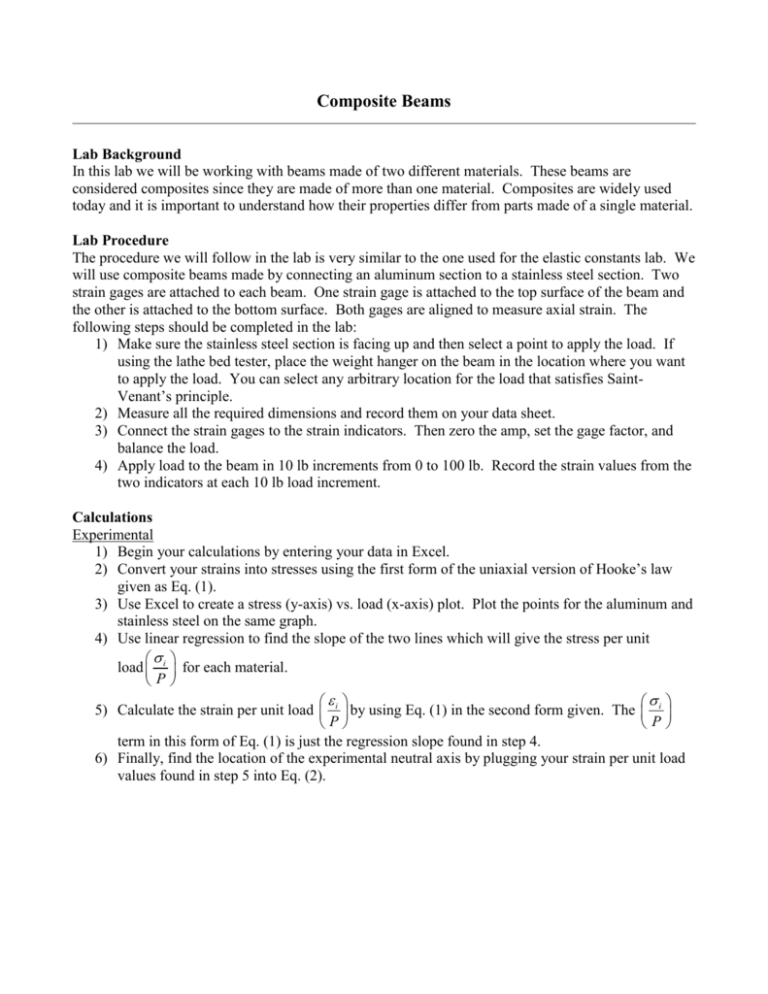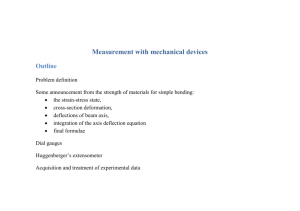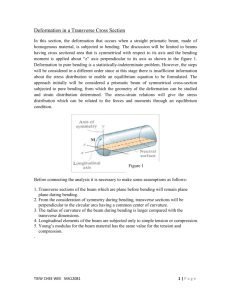handout
advertisement

Composite Beams Lab Background In this lab we will be working with beams made of two different materials. These beams are considered composites since they are made of more than one material. Composites are widely used today and it is important to understand how their properties differ from parts made of a single material. Lab Procedure The procedure we will follow in the lab is very similar to the one used for the elastic constants lab. We will use composite beams made by connecting an aluminum section to a stainless steel section. Two strain gages are attached to each beam. One strain gage is attached to the top surface of the beam and the other is attached to the bottom surface. Both gages are aligned to measure axial strain. The following steps should be completed in the lab: 1) Make sure the stainless steel section is facing up and then select a point to apply the load. If using the lathe bed tester, place the weight hanger on the beam in the location where you want to apply the load. You can select any arbitrary location for the load that satisfies SaintVenant’s principle. 2) Measure all the required dimensions and record them on your data sheet. 3) Connect the strain gages to the strain indicators. Then zero the amp, set the gage factor, and balance the load. 4) Apply load to the beam in 10 lb increments from 0 to 100 lb. Record the strain values from the two indicators at each 10 lb load increment. Calculations Experimental 1) Begin your calculations by entering your data in Excel. 2) Convert your strains into stresses using the first form of the uniaxial version of Hooke’s law given as Eq. (1). 3) Use Excel to create a stress (y-axis) vs. load (x-axis) plot. Plot the points for the aluminum and stainless steel on the same graph. 4) Use linear regression to find the slope of the two lines which will give the stress per unit load i for each material. P 5) Calculate the strain per unit load i by using Eq. (1) in the second form given. The i P P term in this form of Eq. (1) is just the regression slope found in step 4. 6) Finally, find the location of the experimental neutral axis by plugging your strain per unit load values found in step 5 into Eq. (2). Theoretical The composite beam theory is based on transforming the cross section into an equivalent cross section composed of only one material. 1) Begin transforming the cross section by finding the ratio of the modulus of elasticities (n) of the two materials as shown in Eq. (3). 2) Next, multiply the width of the stainless steel section by n. The resulting value is the width of an aluminum section that is equivalent to the stainless steel in flexure. Do not change the height of the stainless steel section when performing the cross section transformation. 3) Find the theoretical location of the neutral axis ( yth ) by finding the centroid of the transformed cross section. 4) Once the neutral axis location is found, calculate the moment of inertia of the transformed cross section about the neutral axis. 5) Finally, calculate the theoretical stress per unit load for the two materials by applying Eq. (4). Lab Report The report for this lab should be a memo written by your group worth 100 points. Make sure to attach your initialed data sheet and show a set of sample calculations. The following shows what is expected in certain sections of your report. Experimental Results Create a table showing the original data collected in lab. Also, include the graph of stress vs. load used in your calculations. You should also report the calculated experimental values for location of experimental neutral axis and stress per unit load for each material. You also need to report the theoretical location of the neutral axis and the theoretical stress per unit load ratios. A table or tables may be used to organize your experimental and theoretical values. Discussion of Results In this section you should compare your experimental and theoretical values for the location of the neutral axis and the stress per unit load for the two materials. Use percent errors to make your comparisons. Discuss how well the composite beam theory predicted your experimental values and give reasons for any major differences. Finally, research two composites and tell what materials are used to create the composites. Also describe how the materials are joined and the benefits gained by using the materials as a composite. Presentation Each group will come to the board and write their experimental values for the neutral axis location and the stresses per unit load for each material. Two random groups will then be asked questions about the lab. Equations (1) Uniaxial Hooke’s Law i Ei i (2) Experimental Neutral Axis h h y exp ss al ss 1 P al 1 i P Ei P i = stress in material i, psi Ei = modulus of elasticity of i material i, psi i = axial strain in material i, in/in P y exp = location of neutral axis, in (from bottom) hss = height of S.S. section, in hal = height of aluminum section, in i P = strain per unit load in material i, in/(in-lb) P = load, lb (3) Ratio of E’s for Composite Beam E n ss Eal n = ratio of E’s Ei = modulus of elasticity of material i, psi (4) Theoretical Stresses per Unit Load Lg L2 L L n g 2 hss hal y th y th L al L ss , P I NA P I NA i = stress per unit load, in-2 P Lg = distance to strain gages, in L2 = distance from load to closest support, in L = length of beam, in I NA = moment of inertia of transformed cross section about neutral axis, in4 yth = location of neutral axis of transformed cross section, in (measured from bottom)








